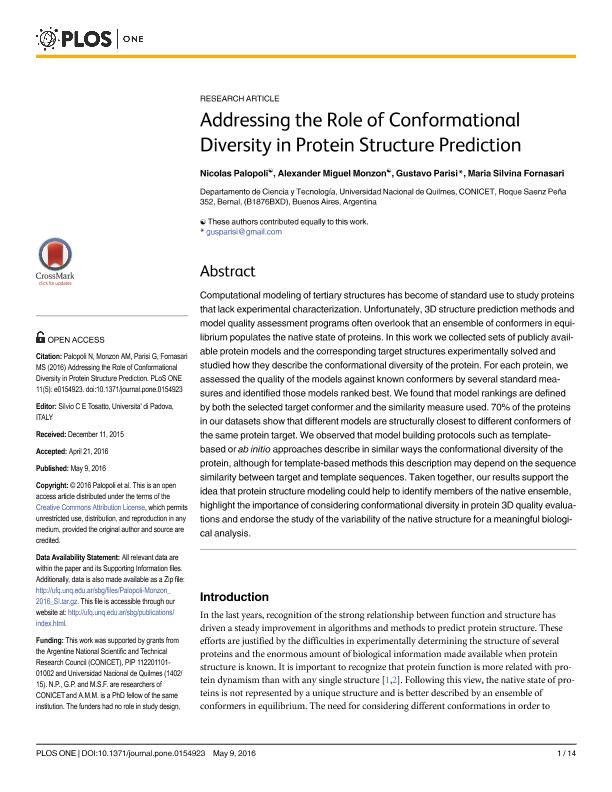Mostrar el registro sencillo del ítem
dc.contributor.author
Palopoli, Nicolás

dc.contributor.author
Monzón, Alexander

dc.contributor.author
Parisi, Gustavo Daniel

dc.contributor.author
Fornasari, Maria Silvina

dc.date.available
2018-03-12T21:35:19Z
dc.date.issued
2016-05
dc.identifier.citation
Palopoli, Nicolás; Monzón, Alexander; Parisi, Gustavo Daniel; Fornasari, Maria Silvina; Addressing the role of conformational diversity in protein structure prediction; Public Library of Science; Plos One; 11; 5; 5-2016; 1-14
dc.identifier.issn
1932-6203
dc.identifier.uri
http://hdl.handle.net/11336/38639
dc.description.abstract
Computational modeling of tertiary structures has become of standard use to study proteins that lack experimental characterization. Unfortunately, 3D structure prediction methods and model quality assessment programs often overlook that an ensemble of conformers in equilibrium populates the native state of proteins. In this work we collected sets of publicly available protein models and the corresponding target structures experimentally solved and studied how they describe the conformational diversity of the protein. For each protein, we assessed the quality of the models against known conformers by several standard measures and identified those models ranked best. We found that model rankings are defined by both the selected target conformer and the similarity measure used. 70% of the proteins in our datasets show that different models are structurally closest to different conformers of the same protein target. We observed that model building protocols such as template-based or ab initio approaches describe in similar ways the conformational diversity of the protein, although for template-based methods this description may depend on the sequence similarity between target and template sequences. Taken together, our results support the idea that protein structure modeling could help to identify members of the native ensemble, highlight the importance of considering conformational diversity in protein 3D quality evaluations and endorse the study of the variability of the native structure for a meaningful biological analysis.
dc.format
application/pdf
dc.language.iso
eng
dc.publisher
Public Library of Science

dc.rights
info:eu-repo/semantics/openAccess
dc.rights.uri
https://creativecommons.org/licenses/by-nc-sa/2.5/ar/
dc.subject
Protein Structure Prediction
dc.subject
Conformational Diversity
dc.subject.classification
Otras Ciencias Biológicas

dc.subject.classification
Ciencias Biológicas

dc.subject.classification
CIENCIAS NATURALES Y EXACTAS

dc.title
Addressing the role of conformational diversity in protein structure prediction
dc.type
info:eu-repo/semantics/article
dc.type
info:ar-repo/semantics/artículo
dc.type
info:eu-repo/semantics/publishedVersion
dc.date.updated
2018-03-12T19:25:42Z
dc.journal.volume
11
dc.journal.number
5
dc.journal.pagination
1-14
dc.journal.pais
Estados Unidos

dc.journal.ciudad
San Francisco
dc.description.fil
Fil: Palopoli, Nicolás. Universidad Nacional de Quilmes; Argentina. Consejo Nacional de Investigaciones Científicas y Técnicas; Argentina
dc.description.fil
Fil: Monzón, Alexander. Universidad Nacional de Quilmes; Argentina. Consejo Nacional de Investigaciones Científicas y Técnicas; Argentina
dc.description.fil
Fil: Parisi, Gustavo Daniel. Consejo Nacional de Investigaciones Científicas y Técnicas; Argentina. Universidad Nacional de Quilmes; Argentina
dc.description.fil
Fil: Fornasari, Maria Silvina. Universidad Nacional de Quilmes; Argentina. Consejo Nacional de Investigaciones Científicas y Técnicas; Argentina
dc.journal.title
Plos One

dc.relation.alternativeid
info:eu-repo/semantics/altIdentifier/url/http://journals.plos.org/plosone/article?id=10.1371/journal.pone.0154923
dc.relation.alternativeid
info:eu-repo/semantics/altIdentifier/doi/http://dx.doi.org/10.1371/journal.pone.0154923
Archivos asociados
